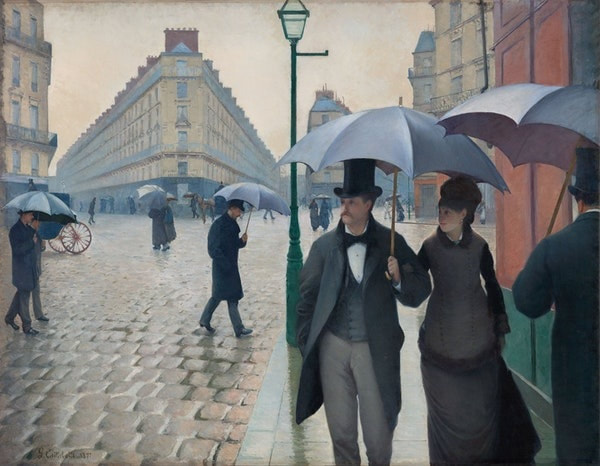Gustave Caillebotte’s Paris Street; Rainy Day (1877) is a prime example of the artist’s innovative approach to capturing the nuances of modern urban life. This formal analysis is focused on how Caillebotte used the elements and principles of art to bring to life a seemingly ordinary, rainy day in Paris. The artist’s keen observation and masterful execution lend this piece its enduring appeal and significance in the annals of Impressionist art.
In Paris Street Rainy Day, Caillebotte extensively used a linear perspective, resulting in an exceptionally detailed and realistic representation of the Parisian streetscape. The orthogonal lines of the buildings, streets, and cobblestones converge to a single vanishing point, drawing the viewer’s gaze deep into the painting and creating a palpable sense of depth (Appendix A). The artist’s meticulous attention to light and shadow enhances the painting’s realism. Despite the overcast sky, light subtly bounces off the rain-soaked cobblestones, umbrellas, and clothing, casting diffused shadows that further contribute to the sense of depth and three-dimensionality.
Color is used to convey a gray, rainy atmosphere and subtly highlight critical compositional elements. Muted grays, blues, and browns dominate the overall color scheme. Still, Caillebotte cleverly introduces pops of color, such as green lampposts and the man’s beige pants, to draw attention to the central figures. Thus, in terms of composition, the placement of the two central figures near the center but not quite at the center creates a dynamic, slightly off-balance feel that reflects the hustle and bustle of city life. The repetition of shapes, such as the umbrellas and the architectural elements, creates a rhythm that guides the viewer’s eye throughout the painting.
In Paris Street Rainy Day, Caillebotte skillfully employed the principles and elements of art. The purpose was to transform an everyday urban scene into a masterful exploration of light, space, and modernity. The painting serves as a testament to the artist’s profound understanding of composition and ability to convey mood and atmosphere through color, light, and perspective.
